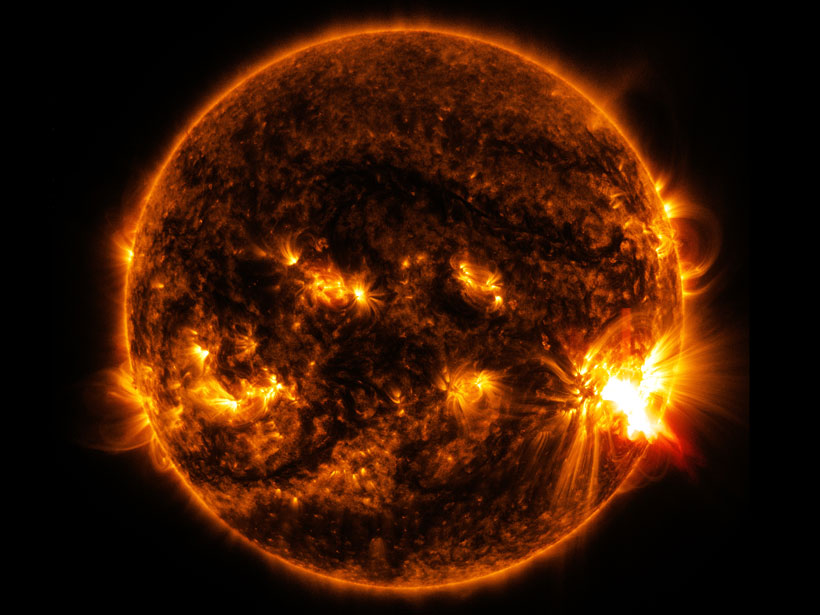Astrophysical shock waves associated with solar flares and coronal mass ejections contribute to space weather that can affect life on (and above) Earth by disrupting cell phone signals and damaging satellites.
Particle velocity distributions and other spacecraft-collected data can be used to solve mysteries about these collisionless shocks and their precursors. However, significant problems still exist with these measurements.
“Spacecraft [data] remain fundamentally limited, as they rely on the inherently noisy process of sampling shock crossings through multiple orbits and have difficulty gauging large-scale, 3D effects due to undersampling,” researchers wrote in a study published 21 June in Physical Review Letters.
For decades, researchers have been trying to understand shock formation and the properties of shocks, but it’s only recently that they have had the diagnostic capabilities to examine these events more closely.
“Up in space, things are always changing,” said Dan Winske, a retired laboratory fellow at the Los Alamos National Laboratory who wasn’t involved with this study. Even if spacecraft visit the same locations multiple times, he said, the original measurements may not be reproducible.
“That’s why lab experiments are undertaken in this field,” he noted.
And now for the first time, researchers have observed “time-resolved electron and ion velocity distributions in magnetized collisionless shock precursors” in such lab experiments. They also detected direct evidence of events necessary for the shocks to form, including piston and ambient plasma coupling and piston ion flow deformation.
The team’s experiments, conducted at the University of Rochester’s Omega Laser Facility, relied on Thomson scattering of a probe laser beam. This technique enabled the researchers to collect time-resolved data on the system’s electron density, temperature, and ion flow speed. The researchers also used two-dimensional proton radiography to map the system’s spatially resolved magnetic fields.
These are “very nice results,” Winske said. For the past 4 to 5 decades, researchers have been trying to understand shock formation and the properties of shocks, but it’s only recently that they have had the diagnostic capabilities to examine these events more closely, he noted.
A Tricky Experimental Setup
Although the existence of Thomson scattering is well known, few researchers have applied it in this context, said Derek Schaeffer, an associate research scholar in Princeton University’s Department of Astrophysical Sciences and lead author of the study. Thomson scattering is “a very powerful diagnostic,” but it’s also “a difficult diagnostic to use well,” Schaeffer said.
The technique utilizes lenses to collect scattered light from laser beams, but those beams are only tens of micrometers wide, Schaeffer said. Thus, even a slight misalignment of the lenses can interfere with their collection of the scattered light.
Also, the technique is most suitable for use with high-density plasmas because they produce the scattering signals needed to result in selective, coherent spectra, Schaeffer said. Laser plasmas can meet this criterion, but there are few laser facilities available, he noted.
Next Steps
Because this experiment didn’t lead to the formation of a shock, Winske said the researchers “need to run it longer.”
Schaeffer, however, said that stopping short of shock formation was “as much out of necessity as anything else.”
In a laboratory setting, it’s challenging to make shocks form with present technology because these experiments are fast paced and energy intensive and “take a lot of magnetic volume,” Schaeffer said. Because incorporating Thomson scattering already made the experiment complex, the researchers opted to stop the experiment at the shock precursor stage.
Going forward, Schaeffer and his colleagues plan to expand their recent experiments to more closely replicate the type of measurements taken in space.
Although the measurements reported in this study were taken in only one direction, “spacecraft probe all three dimensions,” Schaeffer said. Space observations have revealed that in the same area, plasma can behave differently in different directions, so Schaeffer and his colleagues want to make it possible for their laboratory experiments to also reflect this reality.
For the near future, collecting multidirectional data will likely entail setting up the experiment in one direction as was done in the present study, taking the measurements, and then manually resetting the experiment for a different direction, Schaeffer said. However, emerging technologies may eventually make it possible to rotate the setup during experiments without the need for a manual reconfiguration of the components, he noted.
—Rachel Crowell (@writesRCrowell), Science Journalist
Citation:
Crowell, R. (2019), Researchers reproduce processes behind astrophysical shocks, Eos, 100, https://doi.org/10.1029/2019EO131371. Published on 26 August 2019.
Text © 2019. The authors. CC BY-NC-ND 3.0
Except where otherwise noted, images are subject to copyright. Any reuse without express permission from the copyright owner is prohibited.

